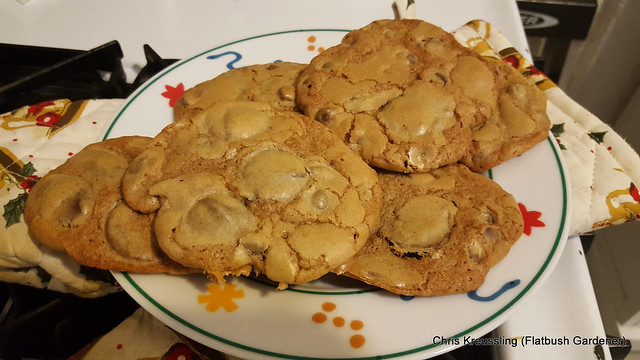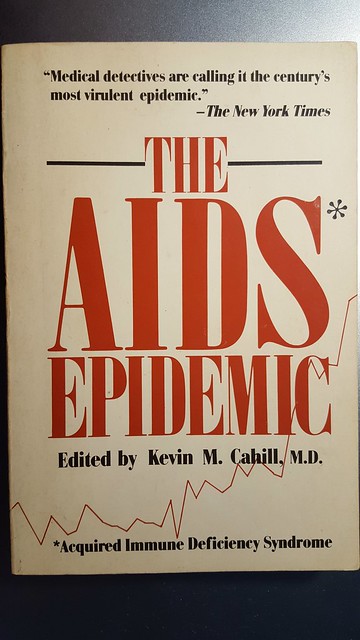
2016-03-12
Off-Topic: The Conversation
I moved to NYC the first weekend of 1979. By Spring, I had moved to the East Village, an epicenter of what was first called "gay cancer," then "Gay-Related Immunodeficiency Disease," or GRID. Four years later, by 1983 - the year of the symposium that led to this anthology - it was being called AIDS.


2016-02-20
Recipe: Crisp and Chewy Chocolate Chip Cookies
2016-01-21
One Score Years Ago
David Joseph Wilcox at Wigstock in Union Square, early 1990s. Scan from original slide, date unrecorded.

20 years ago, on January 22, 1996, my friend, David Joseph Wilcox, died from AIDS.
The last time I saw him was December 12, 1995. I wrote this on my return trip home on the F train back to Brooklyn from the East Village.

20 years ago, on January 22, 1996, my friend, David Joseph Wilcox, died from AIDS.
The last time I saw him was December 12, 1995. I wrote this on my return trip home on the F train back to Brooklyn from the East Village.
2015-12-21
Standing Still
Persephone with her pomegranate. Dante Gabriel Rossetti - Proserpine (Oil on canvas, 1874) - Tate Gallery, London

This season's solstice (Winter in the Northern hemisphere, Summer in the Southern), occurs at 04:48 UTC, December 22, 23:48 Eastern Standard Time (UTC-05:00), December 21.
Illumination of Earth by Sun at the southern solstice.
 Etymology: Latin solstitium (sol "sun" + stitium, from sistere "to stand still")
Etymology: Latin solstitium (sol "sun" + stitium, from sistere "to stand still")
Dona nobis pacem / Let there be peace

This page has a little MIDI file which bangs out the tune so you can follow the score.
2009: Standing Still, Looking Ahead
2008: Stand Still / Dona Nobis Pacem
2007: Solstice (the sun stands still)

This season's solstice (Winter in the Northern hemisphere, Summer in the Southern), occurs at 04:48 UTC, December 22, 23:48 Eastern Standard Time (UTC-05:00), December 21.
Illumination of Earth by Sun at the southern solstice.
The name is derived from the Latin sol (sun) and sistere (to stand still), because at the solstices, the Sun stands still in declination; that is, its apparent movement north or south comes to a standstill.We've had no clear winter here in NYC. It finally got "cold" over the weekend, with temperatures threatening frost, but not quite making. So far, Central Park has had the 3rd longest run of frost-free days in history, and we are within reach of breaking the record.
- Solstice, Wikipedia
Dona nobis pacem / Let there be peace
This page has a little MIDI file which bangs out the tune so you can follow the score.
Related Content
2010: From Dark to Dark: Eclipse-Solstice Astro Combo2009: Standing Still, Looking Ahead
2008: Stand Still / Dona Nobis Pacem
2007: Solstice (the sun stands still)
Links
Wikipedia: Solstice2015-11-29
Extinct Plants of northern North America 2015
I'm limiting this list to northern North America for two reasons:
Franklinia alatamaha, Franklin Tree
Another category is "extinct in the wild," when the species still exists under cultivation, like an animal in a zoo. A famous example of this is Franklinia alatamaha.
IUCN Red List: List of species extinct in the wild
The Sixth Extinction: Recent Plant Extinctions
Extinct and Extirpated Plants from Oregon (PDF, 5 pp)
- Restricting this list geographically is in keeping with my specialization in plants native to northeastern North America.
- There are many more tropical plants, and plant extinctions, than I can manage; for example, Cuba alone has lost more plant species than I've listed on this blog post.
If you have additions to this list, please let me know, and provide a link which I can research.
- Astilbe crenatiloba, Roan Mountain false goat's beard, Roan Mountain, Tennessee, 1885
- Narthecium montanum, Appalachian Yellow Asphodel, East Flat Rock Bog, Henderson County, North Carolina, before 2004?
- Neomacounia nitida, Macoun's shining moss, Belleville, Ontario, 1864
- Orbexilum macrophyllum, bigleaf scurfpea, Polk County, North Carolina, 1899
- Orbexilum stipulatum, large-stipule leather-root, Falls-of-the-Ohio scurfpea, Rock Island, Falls of the Ohio, KY, 1881
- Thismia americana, banded trinity, Lake Calumet, IL, 1916
Extinct in the wild (IUCN Red List code EW)
Extinct versus Extirpated
I often come across misuse of the word "extinct," as in: native plant extinct in New York City.- "Extinct" means globally extinct. No living specimens exist anywhere in the world, not even in cultivation.
- "Extirpated" means locally extinct, while the species persists in other populations outside of the study area. To correct the above example: extirpated in New York City. Any regional Flora lists many extirpated species.
Another category is "extinct in the wild," when the species still exists under cultivation, like an animal in a zoo. A famous example of this is Franklinia alatamaha.
Related Content
Extinct Plants of northern North America, 2014-11-30Links
Wikipedia: List of extinct plants: AmericasIUCN Red List: List of species extinct in the wild
The Sixth Extinction: Recent Plant Extinctions
Extinct and Extirpated Plants from Oregon (PDF, 5 pp)
2015-09-11
Former BBG Herbarium property for sale
Want to build next to the Brooklyn Botanic Gardens? This might be your one and only chance.More like building on the grave of BBG's science and research mission. This is not just "walking distance from the Botanic Gardens;" it's the former site of Brooklyn Botanic Garden's Herbarium, known as BKL.
- Development Site Adjacent to Brooklyn Botanic Gardens Hits Market, Terrance Cullen, Commercial Observer, 2015-09-10
The 22,000-square-foot plot at 111 Montgomery Street in the Crown Heights section of Brooklyn is hitting the market for a potential developer looking to likely build condominiums.According to the NYC Department of Buildings, the property is 109-111 Montgomery Street. BBG quietly announced almost a year ago that they would be "disposing" of:
... BBG’s building at 109 Montgomery Street, which has foundation problems and is not cost effective to repair.Indeed. The Observer article gives "an asking price in the mid-$40 million."
The disposition is expected to generate significant revenue ...
- BBG Announces Disposition of Montgomery Street Building, 2014-10-24
BBG's October announcement made no mention of the herbarium. In their "Freedom is Slavery" double-speak, they claim the sale as "the first step in reintroducing a science research program at the Garden." "Reintroducing" because BBG removed science from their mission in September 2013, with no announcement, just a month after firing their remaining science staff,
BBG planned to transfer the herbarium - again, without announcement - out of state, either to the Missouri Botanical Garden (MOBOT) or the Smithsonian. This would have been a disaster for the natural history and cultural heritage of New York state. It was only through last-minute, behind-the-scenes advocacy and intervention in March of this year that the New York Botanical Garden (NYBG) instead accepted the contents on loan. That move was completed in April.
In June of this year, BBG sold the property to the holding company, 109 Montgomery LLC, for $24.5 million.
According to the president of the brokerage handling the sale of the herbarium property, “There’s a real need for families moving into Brooklyn to buy apartments within the $1 to $2 million range.” But no room for science, at any price.
Related Content
Brooklyn Botanic Garden's Slash and Burn "Campaign for the 21st Century", 2013-08-23Brooklyn Botanic Garden removes science from its mission, 2014-01-20
Links
2015-09-01
Bombus fervidus, golden northern bumblebee, yellow bumblebee
Sunday, while cutting up edited plants into my compost tumbler, I caught sight of something unusual out of the corner of my eye. It turned out to be Bombus fervidus, golden northern bumblebee, or simply, the yellow bumblebee.
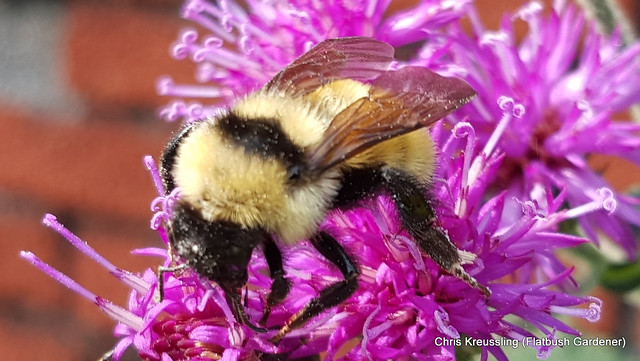
This is at least the 21st bee species I've found in my garden. And this brings to 20, or more, the number of new insect species I've identified in my garden this year alone.
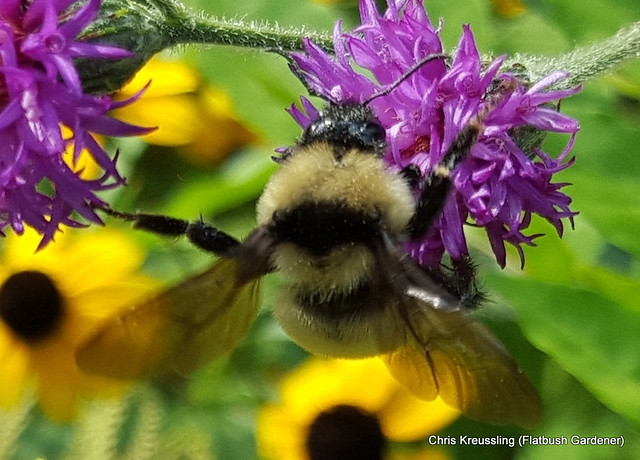
All my bee photo albums
Discover Life: Bombus fervidus
Encyclopedia of Life: Bombus fervidus

This is at least the 21st bee species I've found in my garden. And this brings to 20, or more, the number of new insect species I've identified in my garden this year alone.

Related Content
Flickr photo setAll my bee photo albums
Links
BugGuide: Bombus fervidus, Golden Northern Bumble BeeDiscover Life: Bombus fervidus
Encyclopedia of Life: Bombus fervidus
2015-07-07
Garden Insect Species Records 2015
2015-09-19: Added Homeosoma, observed 10 days ago and just identified, bringing the total to 23.
2015-09-13: Two more Hymenoptera species identified from the last weekend in August: Bombus fervidus, golden northern bumblebee, and Gnamptopelta osidianator, an Ichneumon wasp. And a new Diptera species identified today: Hermetia illucens. That brings the number of species to 22.
2015-07-12: Added two I'd forgotten about: Orius insidiosus, and Anthrenus verbasci. That brings the number of species to 19.
These are the insect species I've discovered or identified in my garden for the first time this year.
2015-09-13: Two more Hymenoptera species identified from the last weekend in August: Bombus fervidus, golden northern bumblebee, and Gnamptopelta osidianator, an Ichneumon wasp. And a new Diptera species identified today: Hermetia illucens. That brings the number of species to 22.
2015-07-12: Added two I'd forgotten about: Orius insidiosus, and Anthrenus verbasci. That brings the number of species to 19.
These are the insect species I've discovered or identified in my garden for the first time this year.
Hymenoptera - Bees
- Bombus fervidus, golden northern bumblebee, yellow bumblebee, 2015-08-30
- Ceratina calcarata, spurred ceratina, small carpenter bee
- Cerceris, two different species, not identified down to species.
- Nomada, cuckoo bee
- Osmia pumila, mason bee
- Stelis louisae, Megachilid bee, cleptoparasite of Megachile campanuelae and perhaps related bees
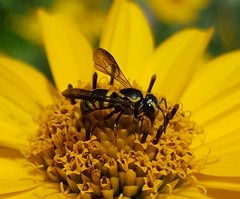
2015-07-01
Pyrrhalta viburni, viburnum leaf beetle (VLB)
Pyrrhalta viburni, the viburnum leaf beetle, or VLB for short, is native to Europe. It was first discovered in North America barely two decades ago, in Maine in 1994. Both larvae and adults eat leaves. Our native Viburnum species are extremely vulnerable; they aren't adapted to this species of leaf beetle. With ample food supply, and no native predators to control its spread, VLB has rapidly expanded its range since.
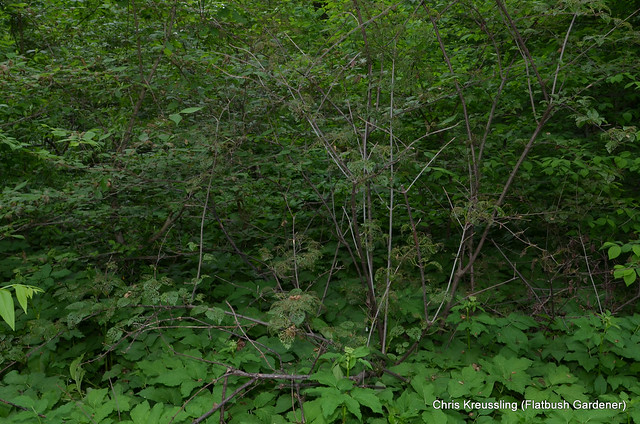
The viburnum leaf beetle, Pyrrhalta viburni (Paykull), is an invasive, non-native beetle that first appeared in New York along Lake Ontario in 1996, and has steadily spread across the state and down the Hudson Valley. It is a voracious eater that can defoliate viburnum shrubs entirely. Plants may die after two or three years of heavy infestation, particularly when larvae strip plants after hatching out in spring followed by heavy adult feeding later in summer.It's been in New York City less than a decade. In Brooklyn, I first observed the damage on Viburnum dentatum, arrowwood, at the Brooklyn Botanic Garden in May 2012. Last year, I found it in Prospect Park; by May, arrowwoods there were shredded.
- Viburnum leaf beetle invading NYC?, Cornell Horticulture Blog, May 2009

2015-06-22
What I'm About
Notice anything different about me? Until a few minutes ago, the by-line at the header of this blog read:
The byline I just replaced reflected the experimental approach I was taking to having so much space to play with. Heirloom plants in the front yard, which might have been available to the original gardener of our home. Shade gardening because what urban gardener doesn't have to deal with shade somewhere? Wild, because something has to be left uncultivated. And always organic gardening.
I've gardened with native plants since my first garden in the East Village. Each of the 4 gardens I've worked on in New York City has incorporated native plants. When we bought our house 10 years ago, I had pretty much a blank slate to work with. I quickly decided that the backyard would be a woodland garden, populated with ephemerals, ferns, and others plants native to the forests of northeastern North America.
Adventures in Neo-Victorian, Wild, Shade, Organic and Native Plant Gardening, Garden Design, and Garden Restoration.It now reads:
Urban Gardening with Native PlantsThis better communicates the focus of my interests and expertise than the "anything goes" byline it replaces.
How I got here
We bought our house and garden 10 years ago. I started this blog 9 years ago.The byline I just replaced reflected the experimental approach I was taking to having so much space to play with. Heirloom plants in the front yard, which might have been available to the original gardener of our home. Shade gardening because what urban gardener doesn't have to deal with shade somewhere? Wild, because something has to be left uncultivated. And always organic gardening.
I've gardened with native plants since my first garden in the East Village. Each of the 4 gardens I've worked on in New York City has incorporated native plants. When we bought our house 10 years ago, I had pretty much a blank slate to work with. I quickly decided that the backyard would be a woodland garden, populated with ephemerals, ferns, and others plants native to the forests of northeastern North America.
Subscribe to:
Posts (Atom)

